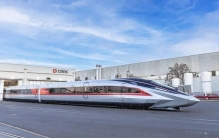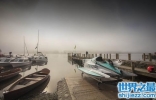飞驰未来:全球最快速度来袭!
On October 17th, the historical moment of the official opening of the Jakarta-Bandung high-speed railway finally arrived. At around 2 p.m., the second-floor waiting room at the starting station, Halim, was crowded with people. Government officials from Indonesia's Ministry of Transportation and State-Owned Enterprises, along with a large number of media reporters, gathered together. Dancers were d

ancing cheerfully while singers were singing passionately. On platform 4, a silver and red train with a Komodo dragon pattern, an Indonesian national treasure, painted on its front and connecting carriage was ready to go."Before, it took us more than three hours to drive to Bandung. I heard that the high-speed train only takes 40 minutes. It's amazing!" said Hani, a Jakarta resident who brought
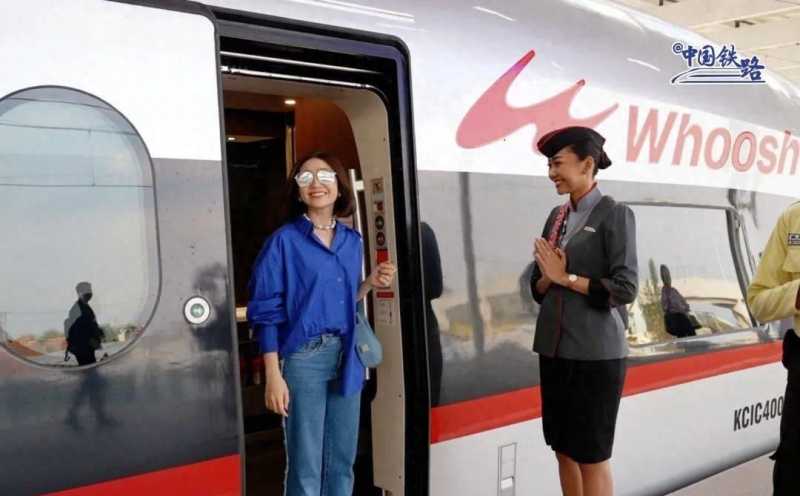
her children to experience the convenience of the modern high-speed train.In the driver's cab, Song Yi, a high-speed train driver from the China Railway Beijing Group Co., carefully checked the equipment status. "Being able to be the first driver of the first train is very meaningful to me. I will drive the train well and bring the benefits of Chinese speed to more Indonesian people!" he said.

At 3:35 p.m., under Song Yi's control, the first train G1137 smoothly started and raced towards Bandung. "Although it is only 142.3 kilometers long, the Jakarta-Bandung high-speed railway is a big step for China's high-speed rail 'going global'!" said Ding Zhisheng, the head of the joint contractor team of the Jakarta-Bandung high-speed railway from the China Railway International Co., Ltd. "The s
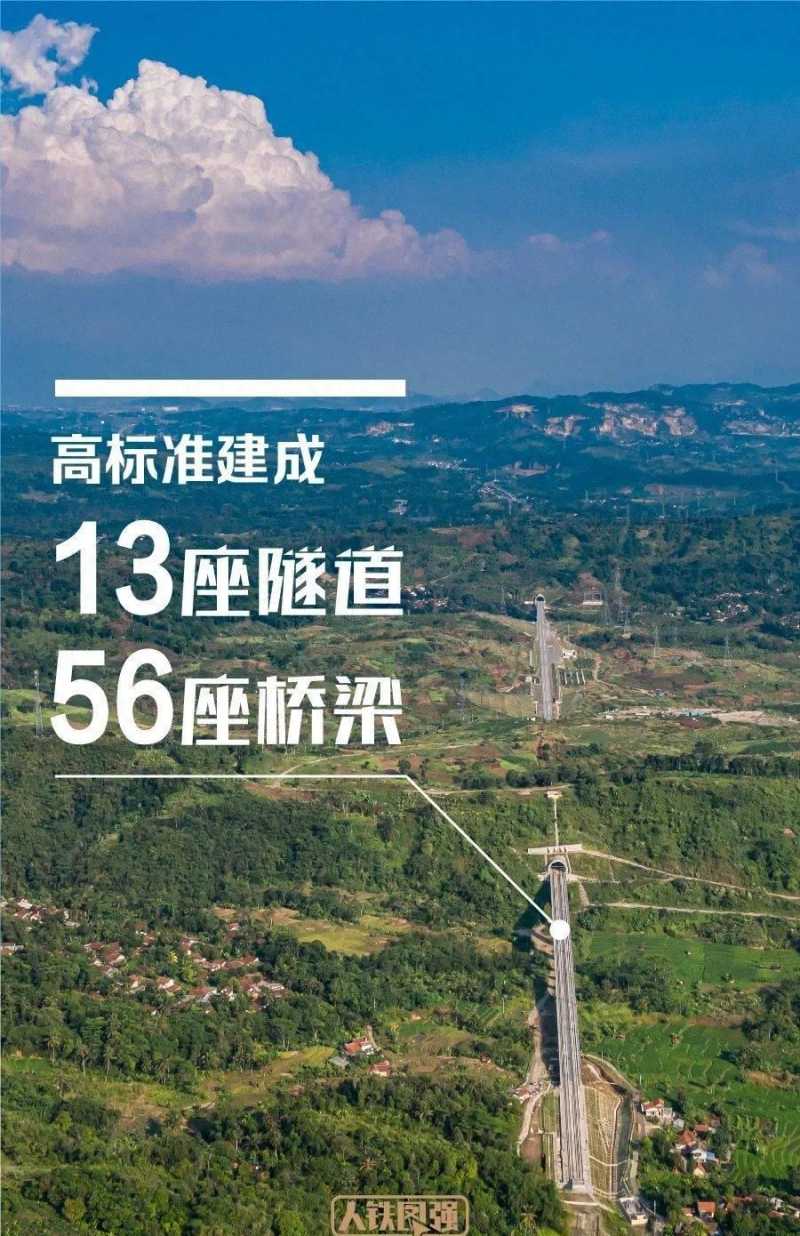
uccess of China's high-speed rail system, which includes all elements and industries, going abroad for the first time, could not have been achieved without the efforts of railway builders."Located in the intersection of tectonic plates, Java Island, where the Jakarta-Bandung high-speed railway is located, is prone to volcanic eruptions and earthquakes, and its geological conditions are complex,

which makes construction difficult. Since June 2018, construction workers from China and Indonesia have worked together to build 13 tunnels, 56 bridges, four modern stations, and one EMU maintenance facility to high standards."286 kilometers per hour, 310 kilometers per hour, 351 kilometers per hour..." The numbers on the train display screen kept jumping and gradually rose to 350 kilometers per

hour. Laughter and photo-taking sounds echoed throughout the train. Some took out their phones to record this moment, some tested the stability of the high-speed rail by placing coins on small tables, while others shared videos and photos on news platforms and social media, expressing their excitement.Walking through the carriages, one can feel a sense of familiarity. According to Li Xiaoliang,
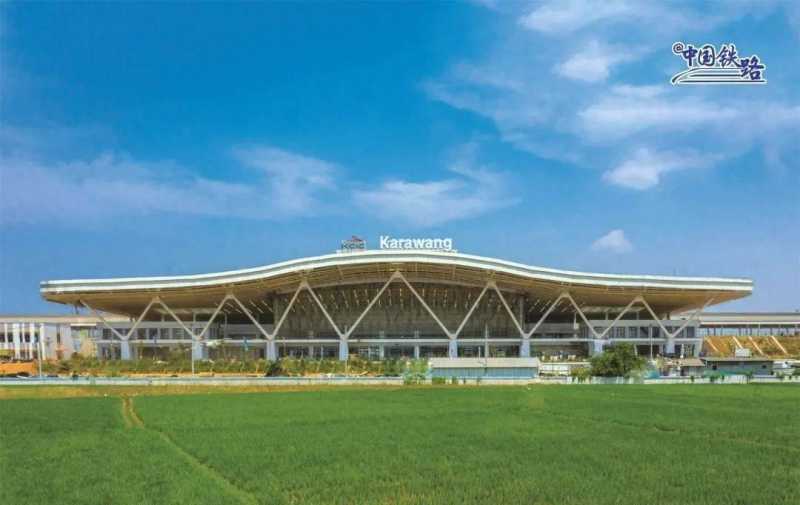
the stationmaster of the rolling stock depot of the CRRC ZELC for the Jakarta-Bandung high-speed railway, the EMU of the Jakarta-Bandung high-speed railway is a "twin brother" of China's Fuxing train. It has undergone some adaptive improvements to fit local running environments and line conditions in Indonesia, integrating Indonesian culture. "For example, to adapt to the marine environment, we i
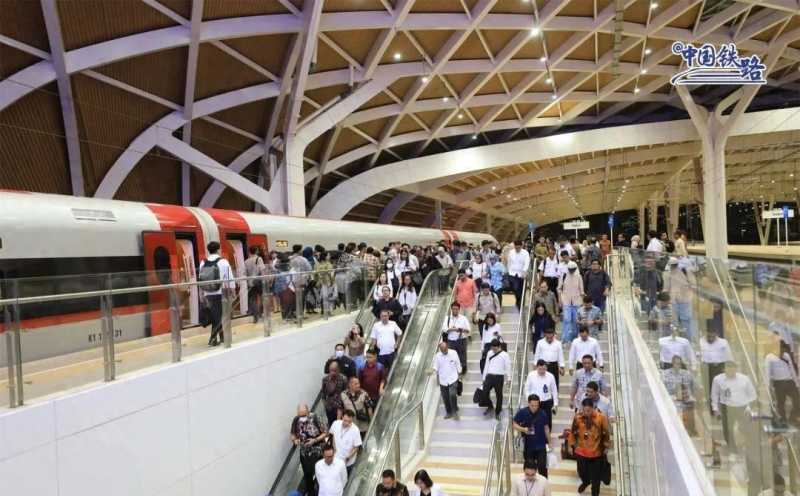
mproved the train's resistance to salt spray and ultraviolet aging. We also added a 'high acceleration mode' to adapt to the steep slope demands, and so on," Li said.At 3:48 p.m., the Padalarang station, the only station where high-speed rail and existing conventional railway could transfer along the entire line, came into view. "The connection between high-speed rail and conventional rail can p

lay a bigger role. I hope that with this high-speed rail, people's mobility will accelerate, and Indonesia's development will be faster and more efficient," said Yusa, a passenger who was taking photos of the train's facilities in the connecting area between carriages 6 and 7. Yusa works in Jakarta and his wife lives in Bandung. He travels between the two cities every two weeks.At 4:21 p.m., the

train arrived at the Dekaraul station in the Bandung area. Outside the station, the distant mountains were like indigo, and the rice fields were like paintings, full of vitality. The Jakarta-Bandung high-speed railway has four stations along the line, two of which are located within the Bandung area, a historical and cultural city where the Asian-African Conference was held in 1955. Thanks to the
high-speed railway, Bandung is now thriving."The Jakarta-Bandung high-speed railway is a 'golden business card' for the joint construction of the 'Belt and Road' initiative between China and Indonesia. It vividly demonstrates China's manufacturing, construction, standards, and image, allowing countries around the world, including Indonesia, to see China's strength," said Zhang Chao, CFO and ris
k executive director of the Indonesian Chinese High-Speed Railway Company (KCIC), adding that the operation of the Jakarta-Bandung high-speed railway is just the beginning, and it will play a leading role in expanding the "Belt and Road" initiative."The Jakarta-Bandung high-speed railway is a road to happiness. We will continue to promote the high-speed rail operation to a high quality and high
level, vigorously cultivate the Jakarta-Bandung high-speed railway economic belt, and bring more benefits to the Indonesian people," said Ju Guojiang, secretary of the Party committee and executive director of China Railway International Co., Ltd.
大家都在看
-
超1亿亩!全球最快、最多! 今天(3月12日)是植树节,据国家林草局消息,2024年,我国完成国土绿化任务超1亿亩。 2024年完成1亿多亩国土绿化任务,包括造林6669万亩、种草改良4836万亩。 森林可持续经营实施面积扩大到1000万亩以上,森林质量 ... 世界最快03-13
-
318公里/小时,世界最快自动驾驶汽车诞生 IT之家 3 月 3 日消息,在肯尼迪航天中心举办的一场汽车活动中,一辆无人驾驶的玛莎拉蒂 MC20 Coupe 以 197.7 英里 / 小时(约合 318 公里 / 小时)的速度,创下了自动驾驶汽车新的陆地速度纪录。此前,这一纪录由印 ... 世界最快03-06
-
时速400公里!全球最快高铁,有新消息 科技日报记者 薛岩5日,全国人大代表、中国中车股份有限公司副总裁王锋向科技日报记者表示,我国最新研制的CR450动车组已经完成样车设计并成功下线,目前正在北京环线铁道进行型式试验。王锋介绍,CR450动车组技术实 ... 世界最快03-06
-
全球最快!1小时直达武汉! 时速400公里!全球最快高铁列车CR450今年要来湖北了全球最快高铁将上线沪渝蓉高铁武宜段试验作为国家“十四五”规划重点工程CR450以运营时速400公里刷新全球高铁速度纪录CR450动车组自2024年12月样车下线后,研发团 ... 世界最快02-27
-
全球最快高铁,有新消息! 不久前,全球最快的高铁列车CR450动车组完成了样车设计并成功下线。眼下,研发团队正在展开一系列科学试验和性能验证,为动车组早日投入商业运营创造条件。科技日报记者 洪星 摄在国家铁道试验中心,工程师们在为CR4 ... 世界最快02-23
-
全球十大最快飞机排名,最快的环绕地球一圈仅需3个多小时。 国之利刃:全球十大最快飞机。这是全球最快的十大飞机,速度快到你怀疑人生。排名第一的飞机只需7分钟就能从上海飞到北京,完全超乎想象。·排名第十位的是美国的F-111战斗轰炸机。F-111战斗轰炸机是美国通用动力公 ... 世界最快01-31
-
世界上速度最快的超级计算机"El Capitan"上线 为美国核储备提供支持 全球最快的超级计算机已在加利福尼亚州劳伦斯利弗莫尔国家实验室 (LLNL) 上线。这台机器名为“El Capitan”经过大约八年的研发,于本月初亮相。它将用于保护美国核储备和机密研究。El Capitan 的峰值性能可达 2.746 ... 世界最快01-29
-
10米/秒!全球跑得最快的“机器猛兽”诞生 央视网消息1月13日,由浙江大学杭州国际科创中心人形机器人创新研究院等单位联合研发的四足机器人“黑豹2.0”正式在杭州发布。“黑豹2.0“整体重量为38kg、站立高度0.63m,身披科技感十足的“战甲”,最快奔跑速度可 ... 世界最快01-15
-
全球最快高铁,亮相→ 记者从中国国家铁路集团有限公司(以下简称国铁集团)获悉,近日,CR450动车组样车在北京发布,这标志着“CR450科技创新工程”取得重大突破,将极大提升我国铁路科技创新水平和科技自立自强能力,进一步巩固扩大我国 ... 世界最快01-13
-
重大突破!全球最快! 12月29日,北京CR450动车组样车首次亮相标志着“CR450科技创新工程”取得重大突破一列CR450AF彰显“锐龙追梦”一列CR450BF寓意“科技之光”未来,CR450动车组投入商业运营后运营时速将达到400公里成为全球跑最快的高 ... 世界最快01-01
相关文章
- 10米/秒!全球跑得最快的“机器猛兽”诞生
- 全球最快高铁,亮相→
- 美媒:中国打破“世界最快高铁”纪录
- 重大突破!全球最快!
- 网友围观世界最快高铁测试,谁有幸第一批坐上国产高速动车CR450?
- 全球最快高铁列车来了
- 主播说联播丨全球最快高铁,有一个设计细节很动感
- 时速400公里!全球最快高铁列车亮相
- 全球最快高铁列车,亮相!
- 时速400公里!全球最快高铁列车正式亮相
- 全球最快高铁列车,来了!
- 亮相!全球最快!
- 重大突破!全球最快列车来了
- 世界倒退最快的国家,从全球第六,大洲第一到一贫如洗仅用了五年
- 世界上速度超快的 18 辆车:能打破陆地速度记录的那些车
- 不同物体之间的速度对比,第一名的速度已达到每秒上百公里。
- 美国匿名客户向中国求购,世界上最快的60KW激光切割机,现已交付
- 全球最快!中国高超音速奇迹
- 世界上速度最快的鞋子,穿上它就能让你行走的速度提升到250%。
- 全球最快航班:只需47秒抵达目的地,网友:上厕所时间都不够
热门阅读
-
世界上最快的快艇,非捷豹莫属。 07-14
-
世界最快的个人潜艇,数秒潜入100米 09-29
-
世界上跑的最快的男孩,100米仅用时13.48秒 04-26
-
世界上速度最快的火箭车,每小时达到1600公里 04-26
-
世界上飞行最快的鸟,灵活的军舰鸟 04-26









